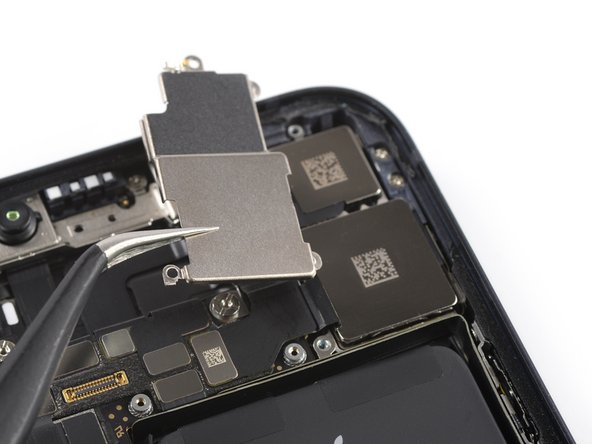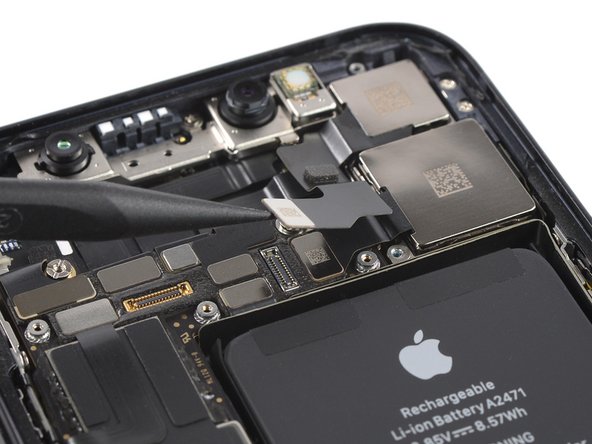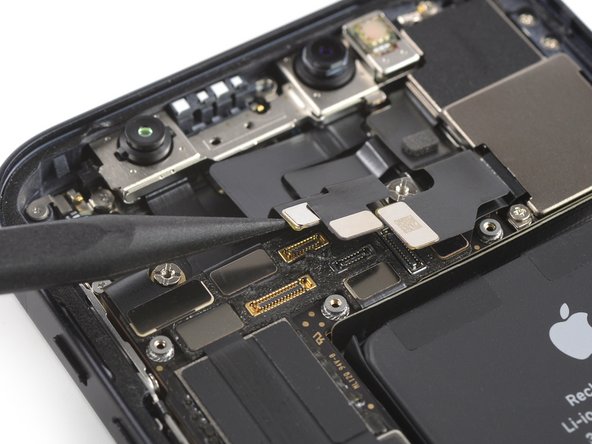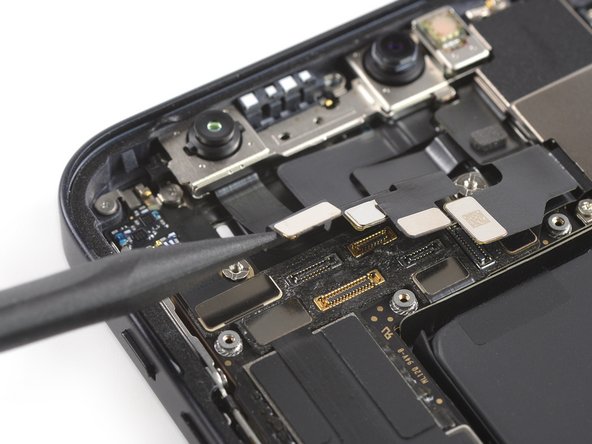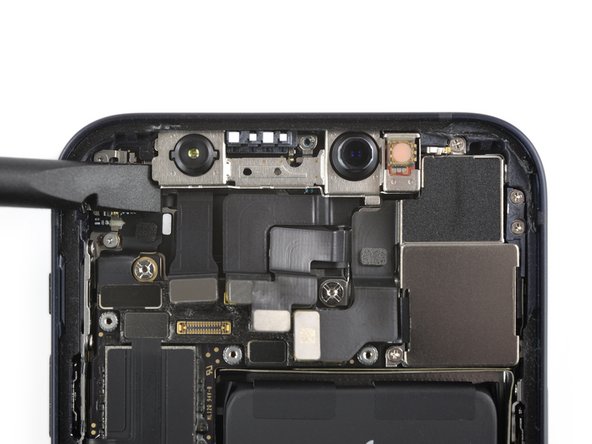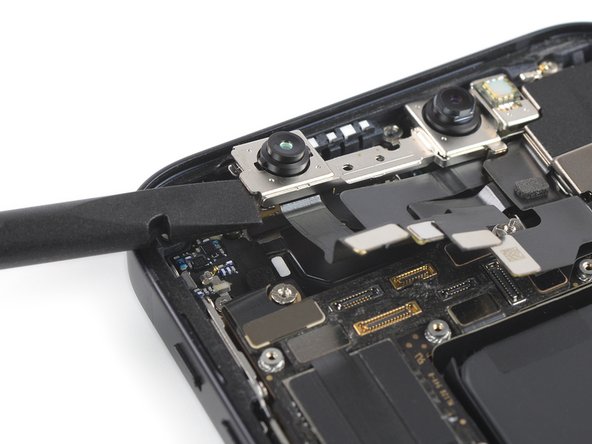iPhone 12 mini Front-Facing Cameras Replacement
Duration: 45 minutes
Steps: 34 Steps
Oops! Looks like Face ID is taking a little vacation and won't be working for now.
Get ready to tackle the task of replacing the front camera assembly (a.k.a. selfie cam) on your iPhone 12 mini! Just a heads-up: swapping this part means Face ID will take a little vacation. This repair will breathe new life into a broken selfie cam, but keep in mind that on iOS 17.6 and earlier, only Apple or an Apple 'authorized' tech can bring Face ID back. If you're rocking iOS 18 or newer, you can easily recalibrate new, genuine front-facing cameras with the help of Apple's Repair Assistant. And don't forget, when you're putting everything back together, you'll need some replacement adhesive to make sure all the components stick around!
Step 1
Before diving in, make sure your iPhone's battery is below 25%. A charged lithium-ion battery is like a firecracker waiting to go off if it gets punctured. Stay safe and keep it cool!
- Before diving in, make sure to power off your iPhone to keep things safe and sound.
- Next up, grab your pentalobe screwdriver and remove the two 6.7 mm screws located at the bottom edge of the iPhone.
Step 2
Pushing the pick in too far can mess with your device's guts, so let’s keep things chill by marking your pick at the perfect spot.
Bonus move: mark the other corners with different measurements for extra precision.
Or, for a DIY twist, tape a coin 3 mm from the tip to set your limit.
- Grab your opening pick and measure 3 mm from the tip. Mark that spot with a permanent marker, so you’ll know exactly where to start!
Step 3
Pop on some safety glasses—you never know when a rogue shard of glass might try to make a break for it.
Got a cracked iPhone screen? Keep those pesky cracks from spreading and save your fingers by taping over the glass before you start poking around.
If the suction cup just won’t stick, try a little superglue magic to get it firmly attached to the screen.
- Cover the iPhone’s screen with overlapping strips of clear packing tape until the entire front is sealed up nice and neat.
- If the suction cup refuses to stick in the upcoming steps, no worries! Fold a sturdy piece of tape (like duct tape) into a little handle and use that to gently lift the screen instead.
Step 4
The next three steps walk you through using the Anti-Clamp, a tool we've created to make opening your device a breeze. If you're not using the Anti-Clamp, just skip ahead three steps for a different method.
Need more details on how to use the Anti-Clamp? Check out this handy guide.
If your iPhone’s surface is too slippery for the Anti-Clamp to grip, a bit of tape can give it the traction it needs. Simple and effective!
- Pull the blue handle back to release the Anti-Clamp's arms.
- Slide the arms onto either the left or right side of your iPhone.
- Place the suction cups close to the bottom edge of the iPhone—one on the front and one on the back.
- Press the cups together to create a good seal and get that suction going.
Step 5
- Grab that blue handle and pull it forward to lock the arms in place—easy peasy!
- Give the handle a smooth clockwise turn, either a full 360 degrees or until the cups start to stretch a bit.
- Keep an eye on the suction cups so they stay perfectly aligned. If they start to drift, just loosen them a touch and realign the arms before moving on.
Step 6
Make sure your opening pick is slid in just right between the plastic bezel and the frame to keep your screen safe and sound.
Take it easy turning—no more than a quarter turn at a time—and give it a minute to work its magic. Let the Anti-Clamp and a bit of patience do the heavy lifting!
If the Anti-Clamp isn’t quite giving you the gap you need, no worries—just add a bit more heat and give that handle a gentle quarter turn. Keep at it, and you’ll get there!
- Place your iPhone on a sturdy surface, like a hardcover book, so it can chill hands-free and stay level with the ground. This will make the upcoming steps a breeze!
- Grab a hair dryer and warm up the bottom edge of your iPhone. It should get just hot enough to feel a little too toasty to touch.
- Give it a minute to let the adhesive loosen up and create a little opening for you.
- When the Anti-Clamp has made a big enough gap, gently slide an opening pick under the screen's plastic bezel.
- Feel free to skip the next three steps.
Tools Used
Step 7
Keep that hair dryer dancing around! Don't let it linger in one spot for too long.
When you open your iPhone's display, keep in mind that the waterproof seals might take a hit. Make sure you have replacement seals on hand, or be extra careful about liquid exposure if you're reassembling your phone without swapping them out.
Heating up the bottom edge of your iPhone will help soften the adhesive that's holding the display in place, making it easier to pry open.
If you're struggling during the opening process, chances are the adhesive has cooled off. Just apply a bit more heat to loosen it up again.
- Grab your trusty hair dryer or heat gun and give the bottom edge of your iPhone a warm hug for about 90 seconds. You want it to be just the right amount of cozy – slightly too hot to touch, but not so hot that it's uncomfortable.
Tools Used
Step 8
- Grab your suction handle and stick it to the bottom edge of the phone, as close to the edge as possible. The closer to the edge, the better the grip!
- If your screen is cracked pretty badly, don’t sweat it—just cover it with some clear packing tape to help the suction cup stick better. If that’s not enough, strong tape can do the job too. And hey, if you're really in a pinch, you can even glue the suction cup to the broken screen to get a good hold. Just be careful!
Tools Used
Step 9
Slide the opening pick under the chunky plastic bezel—your screen will thank you. You’re looking for a visible gap, and that pick should glide right in, not get stuck. No gap? Just gently lift the screen until you spot it.
The adhesive keeping the screen glued down is seriously tough; making that first little gap takes some muscle. If it’s being stubborn, try heating it up a bit more and gently wiggle the screen up and down to soften the glue until you can slip your tool in.
There’s a plastic bezel stuck to the back of the display that lifts with it. Be careful not to stick your pick between the bezel and screen, or you might damage the panel.
- Give that suction cup a good, steady pull to open up a tiny space between the screen and the frame. No sudden moves—just gentle determination.
- Slide an opening pick into that gap, aiming between the screen and the plastic bezel. Steer clear of the screen itself—no poking, just smooth sailing.
Step 10
- Grab a hair dryer and warm up the right edge of the iPhone (the side with the power button) for about 90 seconds, or until the screen feels just a bit too toasty to handle.
Tools Used
Step 11
Keep your pick insertion under 3 mm to avoid messing up any sneaky internal parts.
- Take your opening pick for a spin, cruising around the bottom right corner and along the right side of your iPhone. Slice through that sticky adhesive like a pro—just keep it smooth and steady!
Step 12
- Grab a hair dryer and warm up the top edge of your iPhone for about 90 seconds, or until it feels just a little too toasty to handle.
Tools Used
Step 13
Keep your pick to a maximum of 3 mm—going deeper could put a damper on that front panel sensor array. Stay light and breezy!
The top edge of the display is held in place with a mix of glue and clips, so it's a bit of a stubborn one. Don't worry, though! If you give a gentle tug on the front panel assembly towards the bottom edge of the phone, it’ll make this step a breeze.
- Wiggle your pick under the top-right corner of the screen—don’t be shy, just ease it in.
- Glide the pick around that corner. The clips might put up a fight, but you’ve got this.
- Keep cruising along the top edge with your pick to slice through any sticky spots left behind.
Step 14
- Grab your trusty hair dryer and give that left edge of the iPhone a warm hug for about 90 seconds, or until it’s feeling a bit toasty – just the right amount to handle with care!
Tools Used
Step 15
Heads up! There are two super thin cables chilling along the left side of your iPhone—one near the top, one a bit below the middle. Keep your pick clear of this area so those cables stay safe and sound.
Step 16
Give it a gentle twist—no need to show off your muscles here.
If the adhesive is being stubborn, warm up the left edge again for an easier separation.
- Slide a second opening pick into the bottom left corner of your iPhone.
- Twist both picks together until you hear a satisfying click as the left edge clips pop free.
Step 17
Hold your horses on fully separating the display just yet! There are some delicate ribbon cables still connecting it to the iPhone's logic board, and we don’t want to break any hearts—or cables—during this process.
- Turn your iPhone so the right side is facing you.
- Open up the iPhone by swinging the screen up from the right edge, just like flipping open a book cover.
- Prop the display up by leaning it against something stable while you work on the phone.
- When putting it back together, set the display in place, line up the clips along the top edge, and gently press down the top edge before snapping the rest of the display into position. If it doesn’t snap in easily, double-check the clips around the display to make sure none are bent or out of place.
Step 18
As you dive into this repair adventure, keep a close eye on those screws! Make sure each one goes back to its original home to keep your iPhone safe and sound. You're doing great!
- Take out that tiny 1.25 mm Y000 screw that’s holding the battery and display connector bracket in place.
- When you’re putting things back together, fire up your iPhone now to make sure everything’s working before you close it up. Just don’t forget to shut it down all the way before you dive back in.
Step 19
- Grab your trusty tweezers and carefully lift off the battery and display connector bracket.
- Notice those two tiny hinges hanging out on the right edge of the connector bracket? Keep an eye on them so you line them up perfectly when putting everything back together.
Tools Used
Step 20
Be careful not to mess up the black silicone seal around this and other board connectors. These little guys are the device’s bodyguards against water and dust sneaking in.
- Grab a spudger or even just your clean fingernail to gently lift the battery connector up from its spot on the logic board.
- Give the connector a little bend away from the board so it stays clear and doesn't accidentally reconnect, keeping power off while you work your magic.
Tools Used
Step 21
- Gently lift the OLED panel cable connector off the logic board using a spudger or your clean fingernail—no superhero strength needed, just a little patience.
- When reattaching, line up the connector carefully and press down on one edge until you feel it click, then do the same for the other edge. Avoid pressing in the middle or forcing it, since bent pins can ruin the party. Take your time to get a perfect fit!
Tools Used
Step 22
- Carefully take out the five tiny Y000 screws, each just 1 mm long, that are holding the front sensor assembly cover bracket in place. You've got this!
Step 23
- Grab your trusty tweezers and gently lift out the front sensor assembly bracket. Easy does it!
Tools Used
Step 24
- Grab a spudger or your trusty clean fingernail and gently unplug that front sensor assembly cable connector. You're doing great!
Tools Used
Step 25
- Let's get that display assembly off! It's time to say goodbye to the old screen.
- When you're putting it all back together, take a moment here if you're thinking about swapping out the waterproof adhesive around the edges of the display. It's a great way to keep things snug and dry!
Step 26
Want to make removing the front camera assembly smoother? Unplugging the ultra wide rear camera’s flex cable gives you some elbow room. Totally possible to skip this and go straight to step 23, but putting the front camera back in will feel a bit like a jigsaw puzzle without the picture on the box.
- Unscrew the two Phillips #000 screws, each 1.6 mm long. They’re tiny, so keep track of them!
Step 27
On the right side of the bracket, you’ll spot two tiny tabs tucked into the iPhone’s frame. Grab the left edge of the bracket and slide it toward the volume buttons—gentle but confident moves! That’s the safe way to get it out.
- Grab your tweezers and gently lift off the camera module cover bracket—think of it as giving your phone a little hat removal.
- When putting things back together, make sure those two metal nibs line up perfectly with their matching spots in the iPhone frame. Little details, big difference!
Tools Used
Step 28
- Grab your spudger and gently pop the ultra wide angle camera flex cable straight up out of its socket—easy does it!
Tools Used
Step 29
- Grab your trusty spudger and gently pop the dot projector flex cable straight up from its socket. Easy does it—no superhero strength needed here!
Tools Used
Step 30
- Gently pop up the selfie camera flex cable with a spudger—just lift it straight out of its socket, like you're unplugging a tiny dance partner.
Tools Used
Step 31
- Grab your trusty spudger and gently pry the infrared camera flex cable straight up from its socket to disconnect it.
Tools Used
Step 32
Check out that tiny little nib hanging out on the left edge of the camera module—it needs to be gently popped loose before you can take the whole assembly out.
- Grab a spudger and gently nudge the front camera assembly to the right. Keep going until you spot the metal nib hanging out on the left edge.
Tools Used
Step 33
- Gently use a spudger to lift up the front-facing camera assembly without causing any damage.
Tools Used
Step 34
- Before you wrap things up, check out your new part next to the old one. If there are bits or sticky stuff left to transfer, now’s your chance.
- To put your device back together, just cruise through the steps in reverse. Fresh adhesive is your friend—give those surfaces a quick clean with isopropyl alcohol (90% or higher) for a solid stick.
- Got a newer iPhone and a fresh part? You might be able to calibrate it using Apple’s Repair Assistant (iOS 18 and up). Just update, go to Settings→General→About→Parts & Service History, tap Restart & Finish Repair, and follow the prompts.
- Don’t toss those old parts in the trash—bring your e-waste to an R2 or e-Stewards certified recycler and keep the planet happy.
- If your repair threw you a curveball, try some basic troubleshooting, or hit up the iPhone 12 mini Answers community. And if you need backup, you can always schedule a repair.
































































